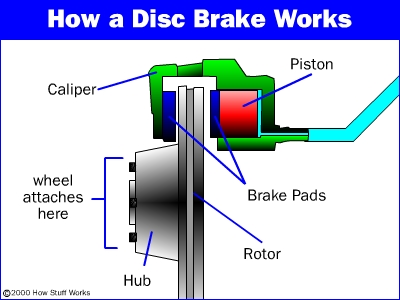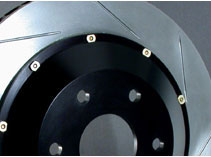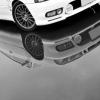The OFFICIAL Brake Upgrade / Big Brake Kit FAQ
The goal is to explain the basics of brake upgrades. This used to be part of the "best coilover" thread but I felt it was worth splitting off so it could be discussed independently.
My brakes suck! How do I fix them?
They don't suck, I swear. They may not feel great, but that does not mean they are not working. Read the rest of the FAQ, but try to remember that pedal feel and stopping distance are not the same thing. You can do some mods that *may* help pedal feel (stainless lines, master cylinder brace) but those will not stop you any faster. Ultimately you are limited by the amount of traction your tires can provide. That is why the tires are one of the most important (and probably overlooked) part of your braking system.
If you are spending money upgrading your brakes and driving around on cheezy all season tires you will not stop as fast as the guy with stock brakes and good summer tires.
Anyway, read on

How do my brakes work?
If you're curious and want to see diagrams and such, HowStuffWorks has descriptions for both disc brakes:
http://auto.howstuff.../disc-brake.htm

And drum brakes:
http://auto.howstuff.../drum-brake.htm
What are some common brake upgrades?
The most common brake upgrades are:
* brake pads
* brake lines
* brake rotors
* brake fluid
* brake calipers / big brake kits, including swapping to bigger rotors
* drum to disc conversion for the older cars
Some other modifications that people do:
* Master cylinder brace
* (suggestions?)
Why would I put on new brakepads?
For the non-STi owners, you would typically switch pads for a few reasons:
-You want better bite out of your brakes
-You want better modulation out of your brakes
-You want to increase your pads' temperature range so they will not fade on you in hard driving. (Fade is discussed later)
For STi owners, the pads are pretty aggressive from the get-go. You still might want to upgrade them for the same reasons as above, but you might also want to "downgrade" them to pads that will dust less. A lot of people think that not having to clean off their wheels is more important than having aggressive pads.
What kinds of brake pads are out there?
http://www.se-r.net/......l#Brake Fade
Quote: 1. Organic - Made of stuff like cellulose, which is like ground up cardboard! The cellulose is held together with a phenolic resin binder which is a heat resistant thermosetting resin. Pot handles and stuff like that is made of phenolics. Organic pads used to have asbestos to give better high temp properties but since asbestos is now a carcinogenic a no-no, kevlar, fiberglass and mineral fillers are now also used. Organic pads have a good coefficient of friction for a light pedal effort, work well at low temperatures and are very quite. They do not work so good for high performance use as they quickly wear, fade, oxidize and crumble. Organic pads are kind of old school and are common on cheap aftermarket replacement pads for older and sometimes new cars. These pads do not wear the rotors very much. Some cars have these as stock pads. Beware of these as they are worse than the stock pads. Suspect any cheap aftermarket pad. Organic pads are usually a light brown or tan in color.
2. Semi-Metallic - These have some powdered metal added to the mix to help stabilize the coefficient of friction at higher temperatures. Typically powdered Brass, iron or Bronze is added. Chopped brass or bronze wire is sometimes added to help give the pad more mechanical strength. Most stock pads on newer car are semi-metallic. Usually these pads are excellent for all-around use. They can run the gamut from very little metal to almost all metal. The more metal usually means better high temp properties, more noise, more rotor wear and less effective cold braking. Semi-Metallics run the gamut from light tan with metal flecks in them to a dark gray in color. The darker pads usually indicate a higher metal content.
3. Full metallic - These pads are made of sintered metal with very little binder. Sintered metal is powdered metal that is pressed into a mold at high temperatures until it becomes a more or less homogeneous piece. Pads of this type are pretty aggressive with ones made of brass, bronze or copper or a mix of metals being more streetable and ones using iron being more high temperature oriented. For very high temperature use, ceramic powder is added to the pad material. Axxiss Metal Matrix pads are streetable nearly full metallic pads that are made of brass and bronze powder with a resin binder. They are very streetable but I would not consider the other pads in this category as usable or even safe for street driving. Full metal pads are noisy, don't grip when cold or wet and chew up rotors with annoying regularity. These pads make killer corrosive black brake dust so clean your rims frequently! I don't think anyone on this list, even racers should consider anything more aggressive than the Metal Matrix or the new carbon pads. These pads are usually a dark gray to black and sometimes even copper-looking with a lustrous sheen.
4. Carbon - Carbon pads available to us mere mortals are not the amorphous carbon-carbon exotica that F-1 cars, the space shuttle and high performance jets use. They are not "carbon-fiber" either. Carbon pads that are available to us normal people are semi-metallic pads that have powdered carbon added to them to improve their high temperature properties. Personally I like most of these pads. For the most part, they have the cold friction of a good mild semi-metallic with the high temp properties of medium aggressive full metallic. Even the full race, high metal/carbon pads seem to have a fairly wide effective heat range. They for the most part are fairly good on the rotors also. Since they work so well over a broad range, carbon pads seem to have taken over the high-performance street pad market. The only drawback that these pads have is cost. They are pretty pricey. In my experience, they seem to wear a little faster than one might expect also. They also leave lots of black, corrosive, yucky, sticky, brake dust which is the main reason I will not use them on my street car. The full race carbon pads seem to eat rotors pretty well to. Carbon pads are a flat dark gray to black with a flinty look. What tradeoffs should I expect with new pads? I want pads that will resist fade, not dust that much and be totally silent.
Cliff notes:
http://forums.nasioc....39&postcount=4
There is no Santa Claus. There is no Easter Bunny. There is no good performance brake pad that does not make brake dust.
Every brake pad is a tradeoff of some variety. If you want better braking you are probably going to have to live with more noise and/or dust and/or rotor wear. This is probably my favorite NASIOC post on the subject, from Tim@StopTech. The orignal post is longer and worth reading; I clipped it to only include the part about brake pads:
http://forums.nasioc....9&postcount=54
Quote: Originally Posted by StopTech The fact of the matter is that current friction technology cannot create a pad that:
1. Is totally silent. (Think of the reputation a noisy pad gets on a message board)
2. Doesn't dust. (Think of the reputation that a dusty pad gets on a message board)
3. Has good cold friction. (Think of the lawyers coming to take away your house because the pad you sold as a street pad didn't stop Joe's car first thing in the morning and he plowed into a mother pushing her twins across the street)
4. Is easy on rotors.
5. Leaves rotors perfectly smooth and mirror-polished.
6. Has good pad life.
7. Does not require the "customer service nightmare inducing" bed-in process.
8. Has a stable torque curve.
9. Fades gradually rather than torque falling off quickly(mid-stop).
10. Has good release and modulation characteristics.
11. Has an MOT that will allow aggressive track use.
12. Does not deposit uneven pad material when overheated.
13. Isn't too expensive.
14. Is available in your pad shape. Why would I upgrade my brake lines?
The lines that come on your car are typically made of rubber, which allows for some flex. By installing stainless steel brake lines, you can eliminate some of that flex and have a firmer pedal.
When shopping for aftermarket brake lines, you should make sure that they are DOT approved. Ideally they will also be coated, just in case your brake lines ever come in contact with something, although that is not a cure-all.
Manufacturers of stainless lines include StopTech, Goodridge and STi.
I've done lots of brake upgrades, but my pedal still feels soft.
First, make sure you have a good bleed. Even some shops screw it up sometimes.
If you have a good bleed and you still feel that your pedal is soft, Mike Shields explains this phenomenon here, the dual stage brake booster:
http://www.spdusa.com/soft.htm
You can switch to a single stage booster, but most people don't bother. I've never driven a car configured that way so I can't speak to how much better it is.
But basically, as Myles says here, you'll never have that "the car is off" feel as long as you're running a brake booster:
http://forums.nasioc....highlight=feel
Quote: Originally Posted by RaceComp Engineering As for getting the "when the car is off" feel,....LOL. forget it, or remove the brake booster and or get racing pedals. It will never feel that way, not to mention most people dont know how to modulate the brakes well enough without a brake booster and be fast or prevent lock up,.......................... Not unless you are a WKA champion and or Star Mazda regular and you live with no brake booster on a daily basis. What are the best rotors?
Basically, for most people, rotors are rotors. I wouldn't go nuts buying bling bling rotors unless they go with your big brake kit. They are chunks of metal that are going to slowly go away over time and that's about it

There are some distinguishing features among rotors:
* two piece versus one piece: Two piece rotors have a lightweight hat in the middle that has the holes that mount to the hub, attached to an outer ring that contains the part of the rotor that the pad will grip. Here's an example:

* Vented versus non vented: For the 02-05 WRX at least, the front rotors are vented but the rears are not. The 06 starts out better, with the 4-pot/2pot setup with vented rotors front and rear. The rears typically do less work, so this is OK. But if you are driving hard enough you may want to upgrade to vented rotors in the rear. (I think the new and old Legacy Turbo have vented rear rotors)
*Slotted versus drilled versus plain: Really there's not much of a reason to use anything but solid. Slotted and drilled have tradeoffs:
* Might get a little bit better bite off of the slots/holes, but might wear pads faster as a result
* More prone to cracking around the slots/holes
* Slots might help a little bit in wet weather.
* Slotted/drilled are usually more expensive.
Basically, most of the problems that slotted/drilled rotors were built to solve are no longer problems. If you really want all the tech explaining why the drilled/slotted stuff is useless, check out this thread:
http://corner-carver...thread.php.html
MaddMatt and Cobra make a compelling case for why drilled rotors are not a good idea
 In addition there is tons of valuable information about brakes in there. You may be thinking "but I have had drilled rotors and they haven't cracked". That's possible, but why risk it? Just for bling? If your brakes fail, you might end up somewhere you don't want to be.
In addition there is tons of valuable information about brakes in there. You may be thinking "but I have had drilled rotors and they haven't cracked". That's possible, but why risk it? Just for bling? If your brakes fail, you might end up somewhere you don't want to be. I think my rotors are warped.
They're probably fine and just need a re-bedding:
http://www.stoptech.....otors_myth.htm
It's possible to warp rotors, for instance if you overtorque or unevenly torque the lugnuts. But most cases where people have warped rotor feel, are not warped rotors.
Here's an excellent thread on the subject:
http://forums.nasioc.....php?t=1151329
What kind of brake fluid should I use?
If you're not tracking your car, you can stick with whatever the car has already. It's really only during track events that you'll see the temperatures that will cause your stock fluid to go out of its range.
Both the ATE Super Blue and Valvoline SynPower have gotten good reviews:
http://forums.nasioc.....php?t=1051150
One nice thing about the Super Blue is that ATE also makes a Typ200 fluid that is the same as Super Blue, but in a gold color instead of blue. This makes it easy to tell when you've fully flushed the system from one to the other.
If you see fade with those, there are some more expensive options like Motul.
You should not use DOT5 brake fluid as it is silicon based and will not work right with your Subaru's brakes. DOT 4 and DOT 5.1 are OK.
I just got new pads. What should I do to "brake" them in?
You need to brake... er... break in your new pads to build a layer of pad material onto the rotor. There are more details here:
http://www.stoptech....dintheory.shtml
http://www.stoptech....edinstock.shtml
The basic jist is: You find a place with very straight roads and no traffic. You do a series of stops from a high speed to a low speed - maybe 60 mph to 10 mph nine or ten times. Then, let the pads cool - i.e. drive on the highway for a while without touching them (if possible) or at least without leaving your foot planted on them (i.e. don't stop on a hill). StopTech recommends doing this cycle twice for street performance pads. I have never done it more than once and it's always worked out OK. Your mileage may vary. It's pretty hard to find a safe spot to do this, and as always, NASIOC does not condone anything illegal or dangerous. Your best bet is to pop a Red Bull at 2 AM and do it while no one else is on the road or something along those lines.
















